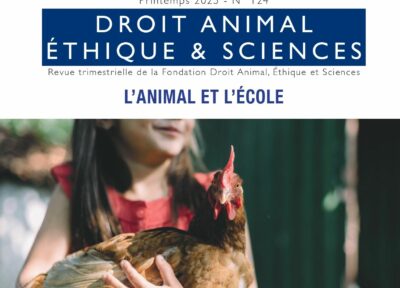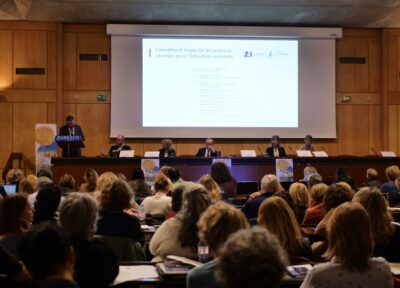by Pr Donald M. Broom
Centre for Animal Welfare and Anthrozoology, University of Cambridge, U.K.
[DOWNLOAD ARTICLE] [Download complete PDF 6.2Mo]
To cite this article (suggested): Broom D.M., « Legally accepted pain and other poor welfare in animals » [PDF file], In: Hild S. & Schweitzer L. (Eds), Animal Welfare: From Science to Law, 2019, pp.165-174.
Summary
Animals kept as pets or for farming, including all mammals, birds and fish, have pain systems and their welfare can be poor because of pain or fear. The extent of pain can be measured using physiological and behavioural measures such as thermography or grimace scales in sheep, horses and mice. It is important to evaluate the magnitude of poor welfare, a function of severity and duration.
In general, our laws prohibit treatment of animals that causes pain or other poor welfare. However, there are exceptions in laws for reasons of tradition, financial cost, gastronomic preference, convenience in management or breeding, or avoidance of other problems. Some activities that harm animals are considered to be “sport”. For example the bull pierced by numerous lances in the corrida, the deer chased by dogs and by humans on horseback, or the dog or cock forced to fight. These “sports” have entirely negative effects for the animal. Another example is the animal killed during shechita or halal slaughter without prior stunning. The justifications for this are: tradition, edict from an interpretation of a holy book, and the mistaken belief that blood in a carcass is in some way unclean.
Evidence from welfare assessment studies shows that: cutting the throat without prior stunning causes up to two minutes of extreme pain. Castration, disbudding, or beak-trimming, without anaesthetic or analgesic causes pain for many hours, and often leads to more prolonged pain because of neuroma formation. Tail removal prevents normal defence against flies in cattle and social signalling in pigs and dogs. Tail-biting by pigs and injurious behaviour by hens can be prevented by giving the animals manipulable materials and more space. This costs more but the painful procedures can be avoided. Foie-gras production necessitates confined rearing conditions, aversive force-feeding and failure of the detoxifying function of the liver so that death would result soon after the normal killing time. Caponising is a major operation that is painful and the wounds take some days to cease to cause pain. In all these cases, the main beneficiary is human and the cost is borne by the animal.
1. Introduction
Legislation and philosophical arguments about how animals should be treated refer to the welfare of the animals. The welfare of an animal is its state as regards its attempts to cope with its environment (Broom 1986). Well-being has the same meaning as welfare but welfare is considered more precise so is more often used in scientific and legal documents. Welfare is a characteristic of an animal at a particular time and should be translated into French as bien-être, not as bien-traitance which, like animal protection or good husbandry, is a human activity. The term “quality of life” means the same as welfare but is not normally used for brief periods of life, whereas we can consider the welfare of individuals over periods lasting for seconds, hours or years (Broom 2007). Welfare includes positive and negative feelings and the state of other mechanisms for coping and it can be assessed scientifically, for example by measuring behaviour, physiology, injuries or the functioning of systems for coping with disease (Fraser 2008, Broom 2014, 2016e, Broom and Fraser 2015). The evaluation of the strength of animal preferences is also important so that we can find out what conditions to use for animals in order to avoid poor welfare and maximise good welfare (Duncan 1992, Dawkins 2006, Kirkden et al. 2003).
Pain and fear are important aspects of suffering and poor welfare and measurement of these in farm animals has been the subject of the recent E.U. funded Animal Welfare Indicators (AWIN) project. There is clear scientific evidence for pain and fear systems in all vertebrate animals, including fish, and some invertebrate animals such as some molluscs – Cephalopoda (Octopus, Loligo, Sepia) and some crustaceans – Decapoda (Cancer, Homarus, Palaemon) (Elwood 2012, Broom 2013b, 2014, 2016b, Mather 2013, Sneddon et al., 2014). All of these are sentient (Duncan 2006, Broom 2014, 2016 a, c).
2. Pain assessment
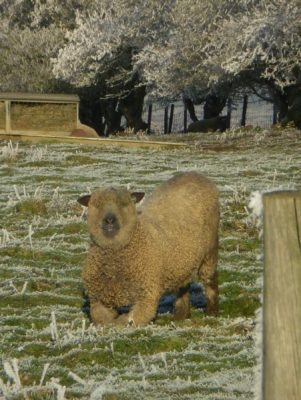 |
How can we identify and assess pain? There has been recent AWIN work on sheep, horses and goats (McLennan et al. 2016). Indicators of pain during foot-rot, mastitis and pregnancy toxaemia were investigated. If a sheep is “standing” with its front feet bent under it so that it can avoid putting pressure on them (Fig. 1), the probability of pain in the feet is very high. This has long been known but it has recently been found that, when a sheep is in pain, it shows changes in facial expression that can be evaluated. Fig. 2 shows a normal sheep and Fig. 3 a sheep that is in pain. Many sheep with painful lesions show: orbital tightening, cheek tightening, ears turned down, and change in the shape of the mouth and nose. This is called a grimace and a very similar combination of movements is a pain indicator in humans. A scale of different intensities can be compiled and sheep showing this grimace had painful pathologies recognisable from other clinical signs (Corke et al. 2015, McLennan et al. 2016). The “grimace scale” can also be used for horses, mice, rabbits and other species (Keating et al., 2012, Defensor et al., 2012, Dalla Costa et al., 2014).
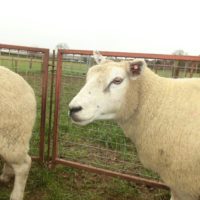
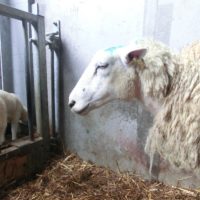
There are many other behavioural and physiological indicators that can be used to quantify pain. For example, pain is also indicated by inflammation, as measured in sheep with foot-rot, by thermography and several blood chemicals. These various indicators of pain cease to be shown when the clinical condition disappears or when an effective anaesthetic or analgesic is used. As Flecknell et al. (2011) pointed out, the major challenge for pain research is being able to assess the emotional side of pain but the close correlation between the behavioural measures and the physiological changes strongly suggest that all of these measures indicate the negative pain feelings associated with pathology and tissue damage in these studies.
There are many indicators of good and poor welfare. Welfare indicators, like those described above, provide quantitative information about how much pain and other poor welfare is caused. However, the duration of the pain is important as well as its severity. When welfare is evaluated, the relationship between intensity and duration should be taken into account (Broom 2001), for example as shown in Fig. 4.
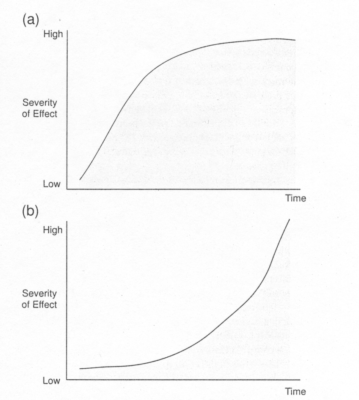 |
In Fig. 4, the area under the plot of severity against time is the magnitude of poor welfare. The maximum severity is the same in each example but the magnitude of poor welfare is much greater during procedure (a) than during procedure (b)
If an effect, like that shown in Fig. 4, is a benefit, the intensity of positive effects is measured and the magnitude of good welfare determined.
3. Examples of legally accepted pain or other poor welfare
In general, our laws prohibit treatment of animals that causes pain or other poor welfare (Broom, 2017). However, there are exceptions to these laws that permit pain or other poor welfare to be caused to animals. The following list shows some reasons for exceptions to laws intended to prevent poor welfare:
- veterinary treatment,
- tradition,
- convenience in management,
- financial cost,
- gastronomic preference,
- training of animals,
- entertainment (sport),
- breeding,
- keeping animal that injures others.
In all of the cases described in sections 3.2 to 3.8, the main beneficiary is human and the cost is borne by the animal. The examples are explained in more detail by Broom and Fraser (2015).
3.1 Veterinary treatment
When medical or veterinary treatment is carried out, in some cases pain is caused to the patient. This is permitted by law, even if in some cases the pain is substantial. In recent years, veterinarians have become accustomed to use anaesthetic or analgesic to mitigate any pain. Whilst the use of pain reduction methods is now widespread for companion animals, it is much rarer for farm animals. The pain system is just as well-developed in a cow as in a dog so failure to prevent pain in cows during veterinary treatment would seem to be morally wrong.
3.2 Traditional activity, entertainment or sport
Bull-fighting is a traditional activity that is permitted in some countries. In the course of the corrida, the bull is pierced by numerous lances and other weapons.
There is no possibility that this can occur without the animal feeling pain. The suggestion that the bull does not feel pain because of the high concentration of endorphins in his blood is not supported by evidence.
During the hunting of deer or foxes with packs of dogs, the animal is chased by dogs and by humans on horseback. This chase must always cause much fear to the chased animal, especially when it realises that capture by the dogs and humans is likely or imminent. Fear is often more important than pain as a cause of poor welfare. The chase in a deer hunt may last for more than an hour. Animals caught by packs of dogs may suffer much pain before they lose consciousness. The fact that wild animals may suffer in the same way when chased by wild predators does not alter the magnitude of poor welfare for the chased animal or the responsibility of people not to cause extreme suffering. Shooting animals accurately causes no poor welfare if death is instantaneous. However, shooting, poisoning or trapping that takes a long time to kill results in a high magnitude of poor welfare.
When a dog or cock is caused to fight by humans who are entertained by the spectacle, it will be caused injuries that can be extremely serious and painful. The duration of the poor welfare may be relatively brief, if the animal is killed soon after the fight, or much more prolonged if the injured animal is kept while it heals.
All of these “sports” have major negative effects for the animal. What is the moral principle to consider in relation to such human activities? One approach is the deontological in that many people say that it is wrong to cause the poor welfare associated with the animal’s pain and fear. Another approach is the consequentialist in which the cost for the animal is set against the entertainment benefit for humans. Most people resolve such issues by a combination of deontological and consequentialist arguments (Broom, 2003).
3.3 Convenience in management and financial cost
Mutilations of animals, i.e. deliberate damage to living sensitive tissue of animals, are permitted to facilitate ease of management of farm, companion and working animals. The impact of the mutilation on welfare will depend on whether or not adequate anaesthesia and analgesia are used, how much loss of function is caused and any benefit of the mutilation that can be set against the pain or other poor welfare. Some examples of mutilations are mentioned briefly here and described at greater length, quoting references, by Broom and Fraser (2015).
Castration of animals is used to facilitate control of reproduction and sometimes to reduce unwanted but natural behaviours. If pain is not prevented using anaesthesia for the consequences of the first actions and analgesia for the post-operative pain, the procedure itself causes very poor welfare. For some methods, such as use of a tight rubber ring around the scrotum in lambs, kids or calves, the severe pain is prolonged. Some negative consequences and benefits of castration last for the whole life of the animal.
Removal of horns or antlers after they are formed is a substantial and painful operation. Disbudding, which entails destruction of the growing horn areas before horn formation involves painful tissue destruction using mechanical means, a hot iron, or strong alkali. All cause great pain so anaesthesia and analgesia should always be used.
Removal of the sensitive area, which includes important sense organs, behind the beak tip, in chickens or other farmed birds is called beak-trimming. This is often done without anaesthetic or analgesic, it causes pain for many hours, and it often leads to more prolonged pain because of neuroma formation.
Tail removal from dogs, pigs, cows or horses is a painful operation, prevents social signalling in pigs and dogs and prevents normal defence against flies in cattle. Tail-biting by pigs and injurious behaviour by hens can be prevented by giving the animals manipulable materials and more space. This costs more but the painful procedures can be avoided.
3.4 Tradition, gastronomic preference and convenience in management
Foie-gras production necessitates confined rearing conditions, aversive force-feeding (Fig. 5) often with injuries to the oesophagus and failure of the detoxifying function of the liver. The toxins that are not destroyed because of liver malfunction can cause pain, malaise and early death. The welfare of ducks during foie-gras production is reviewed by Rochlitz and Broom (2017).
The eating of capons necessitates caponising, i.e. removal of the internal testes by opening the body cavity. This is a major operation that is painful and the wounds cause pain for some days.
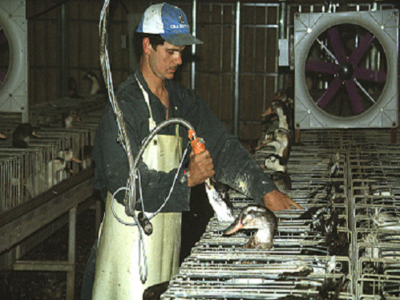
3.5 Training animals
Many owners of companion animals, guard dogs, dogs used for retrieving horse used for social riding and horse used for sport train their animals using pain as a reinforcer. Although reward-training is also used, punishment-training is widely used. This is legal, unless deemed excessive, but causes pain and other poor welfare to the animal. There have been many prosecutions of animal trainers found to be using cruel levels of punishment, sometimes as a result of the actions being recorded on video.
After training, or in the course of it, or in the absence of it, an owner may beat a dog that does not do what the owner wants it to do, or that does something that the owner does not want. In order to restrict dog movements, owners may use shock collars. These can easily be misused by delivering a particularly painful shock so they should not be sold to the general public. A form of training used on farms is the electric fence. Most animals learn by having one negative experience with an electric fence, or by observing another individual have such an experience. If the fence is readily recognisable and the animal can control whether or not it touches the fence, the use of electric fences is justifiable provided that the shock is not extreme.
3.6 Breeding
It is legal to genetically select farm animals in order to increase production efficiency. However the E.U. Directive (98.58.EC Concerning the welfare of animals kept for farming purposes) specifies that this may not be done if the welfare of the animals will be poor because of the selection. Despite this Directive, meat chickens have been selected for fast growth with the result that many of them have considerable leg pain, difficulty in walking, hock burn and breast blisters. The breeding procedure could be challenged legally but, at present, this amount of pain and other poor welfare is seldom the subject of legal action. Since the broiler chicken is the most numerous animal kept by man and the extent of poor welfare is large, this constitutes the greatest animal welfare problem in the world today.
Dog breeds have been selected for various cosmetic characteristics that are associated with pain and other poor welfare. Among the disorders resulting from breed selection are hip-dysplasia e.g. some German Shepherds, having a brain that is too large for the skull e.g. some Cavalier King Charles Spaniels, and a range of breathing problems, especially in brachycephalic dogs. It would seem that current laws should allow the prosecution of breeders who breed such dogs.
3.7 Keeping an animal that injures others
Some people train dogs to be dangerous to humans and other dogs in order to protect their property or to use the dog as a weapon. Whilst the law is sometimes invoked when a dog attacks a person, and the dog and owner can be apprehended, some pain and poor welfare is caused to people and to other animals by such dogs without retribution.
Some cats are kept for pest control. These animals may limit their attacks on other animals to rodents, that is to the target desired by their owners. The cats do cause pain to some of the rodents that they kill but many are killed rapidly so there is a low magnitude of poor welfare. A much greater problem is that many of those who own cats allow their animals to roam outside the owner’s house and to kill wildlife. Some cats catch a prey mammal or bird and then release it and catch it again thus torturing it. This is often one of the worst examples of poor welfare caused to any animal. The fact that wild animals may sometimes also do this does not alter the fact that, when it is done by an owned cat, the owner is responsible for the poor welfare and should prevent it.
3.8 Legal killing of farm animals that causes pain
3.8.1 Humane killing
Laws concerning the killing of animals require that the procedure is humane. Humane means the treatment of animals in such a way that their welfare is good to a certain high degree (Broom 2013a, Broom and Fraser 2015, Chapter 22). Hence the term humane is an absolute one. The procedure is either humane or it is not and it is not possible to talk about the degree of humaneness. However, the extent of poor welfare can be measured during killing procedures.
The generally accepted principles of E.U. legislation (E.U. Regulation 1099/2009) is that humane killing implies:
- the treatment of the animals just before the stunning or killing procedure does not cause poor welfare and
- the actual stunning or killing procedure results in instantaneous insensibility.
or
- if the agent causing insensibility or death is a gas or injectable substance, whether or not it is detectable by the animal, there is no poor welfare before insensibility.
- During insensibility, a killing method is carried out so that recovery of consciousness does not occur before death.
This is normally cutting the throat so that the animal dies from blood loss.
These principles are used when considering any form of killing (Broom 1999), for example the killing of seals on ice-floes (Broom 2014 Chapter 11, Broom 2016). The European Food Safety Authority (EFSA) has published guidance on stunning methods (EFSA 2004, 2006, 2013 and others on poultry, pigs and farmed fish).
3.8.2 Religion and tradition in killing: effects on welfare
When halal (Muslim) and shechita (Jewish) slaughter methods were first developed, accurate and reliable stunning was not possible so these methods were the best that could be carried out. Indeed, the word halal refers to the purity of the action. Now, good stunning procedures exist but the traditional methods are regarded as important by many people. However, these methods are the result of interpretations of holy books rather than statements in the most holy texts. In some countries, killing by cutting the throat without stunning is permitted for halal or shechita slaughter. In other countries stunning is legally required for all farm animals.
A recent development in many countries is that, during some halal slaughter, the animal is stunned at the same time (within five seconds) that the throat is cut. The welfare of the animals is very much better if this is done.
In one interpretation of Jewish holy books there is the idea that blood, blood vessels and some other tissues should not be consumed because they are unclean. It is never possible in any circumstances to eat the meat of animals without consuming some blood. Blood is not harmful to human consumers. Neither is the eating of blood vessels. If tendons are eaten, the material is harder and less digestible than other meat tissue but any minor risk of choking is readily avoided. Biologically, the avoidance of blood, blood vessels, and other parts of muscles is not logical.
3.8.3 Do stunning procedures work?
If applied properly, the methods of stunning used in commercial slaughterhouses that follow E.U. law result in insensibility that is instantaneous. Gibson et al. (2009c) recorded the electroencephalogram (EEG) in calves stunned with a captive-bolt gun. The total power of the EEG (Ptot) decreased sharply at the point of the stun, verifying that stunning had occurred. There is similar evidence for other stunning procedures.
How often are animals not stunned properly? An analysis of the use of a captive bolt gun in an efficient mammal slaughterhouse indicated that 0.1% of animals were not stunned on the first occasion that this was attempted. However, the time taken for a repeat stun when stun failure was detected was normally 10-15 seconds.
Some individuals working in slaughterhouses are less careful and less efficient in their work than others. If there is video-recording in a slaughterhouse, bad treatment of animals pre-stun is much reduced and inadequate stunning is reduced.
3.8.4 If shechita or halal is used, does the animal suffer and how much?
When the throat of a mammal is cut, this cut does not anaesthetise the animal.
One source of evidence for this is that people whose throats were cut and who lived, reported that they felt extreme pain. Another, more precise, source of evidence comes from recording from the brain and describing behavioural responses after the throat of a farm animal is cut. This indicates that consciousness continues for about 20 seconds in sheep, 120 seconds in chickens and 126 seconds in cattle). If the gill region of fish such as salmon in cold water is cut, consciousness persists for up to 20 minutes (Daly et al., 1988, Gregory, 2007, Broom and Fraser, 2015). It has been suggested that cutting the throat leads to suppression of pain as a result of secretion of endogenous opioids with an analgesic effect. However, there is no evidence that this occurs.
Gibson et al. (2009a) recorded EEG while the throat was cut by a ventral-neck incision. The response was consistent with the cut causing severe pain. The EEG indications of pain were also present if the neck tissues were cut but not the blood vessels (Gibson et al., 2009b). Much of the pain results from the neck tissue damage. If stunning with a captive-bolt gun was carried out within 5 s of the throat being cut, the EEG flattened, indicating unconsciousness (Gibson et al., 2009d). Whilst stunned animals do not suffer, the welfare of animals killed without prior stunning is always very poor for 20 to 126 seconds.
Stunning at the time of cutting the throat would be widely accepted on animal welfare grounds. Many halal slaughterhouses now do this in the U.K. and it is accepted by most Muslims and some Jews in countries where cutting the throat without prior stunning is illegal.
3.8.5 Is the stunned animal alive when the throat is cut?
The EEG data show that the properly stunned animal is still alive at the time that the throat is cut. If left without being killed by cutting the throat, the animal will recover. The only exceptions to this occur if wrongly adjusted equipment is applied to the animal. This has been shown to be the case with some head to body stuns but it can be completely avoided by proper adjustment of the equipment, as required by law in many countries. When stunning equipment is of good quality and is properly checked, the animals that are stunned remain alive and capable of recovery until they are killed by cutting the throat.
3.8.6 Is the blood removed from the body after slaughter?
It is thought by some that leaving blood in a carcass is unclean and that blood is not lost efficiently from the hindquarters of an animal. As a consequence, some Jews consider that meat from the hindquarters is not Kosher and will not eat it. It is put on the general market without labelling. Whilst some of this meat goes to the Muslim market, nobody who eats meat can be certain that the animal was properly stunned
Most of the blood is exsanguinated whether the animal is conscious, unconscious or recently dead.
However, no animal is ever completely exsanguinated from any part of its body.
The forequarters and hindquarters still have a little blood in them.
This small amount of blood does not cause any disease problems so, scientifically, the carcass is not unclean because of it.
3.8.7 Can consumers avoid meat from animals that are not stunned?
Most consumers do not wish to eat meat unless the animal has been properly stunned and many find it extremely offensive to consider that they might unknowingly eat such meat. Whilst some of the meat from the hindquarters of animals after Kosher slaughter goes to the Muslim market, nobody who eats meat can be certain that the animal was properly stunned.
What can consumers do about this? In countries where religious slaughter is allowed, it is possible for members of the public to avoid eating meat in restaurants or other places where they are told that the animals have been killed in this way. However, it is necessary to label meat from animals killed in these inhumane ways, without stunning at the time of slaughter, in order that restaurant owners and the public can make this choice. At present this is seldom done. It is particularly important to label the hindquarters of animals killed by shechita. Consumers can ask questions, demand labelling and refuse to buy products from restaurants or retailer shops who cannot provide guarantees.
References
Broom, D.M. 1986. Indicators of poor welfare. British Veterinary Journal, 142, 524-526.
Broom, D.M. 1998. Welfare, stress and the evolution of feelings. Advances in the Study Behavior, 27, 371-403.
Broom, D.M. 1999. The welfare of vertebrate pests in relation to their management. In: Advances in Vertebrate Pest Management, ed. P.D. Cowan and C.J. Feare, 309-329. Fürth : Filander Verlag.
Broom, D.M. 2001. Coping, stress and welfare. In: Coping with Challenge: Welfare in Animals including Humans, ed. D.M. Broom, 1-9. Berlin: Dahlem University Press.
Broom, D.M. 2003. The Evolution of Morality and Religion (pp.259). Cambridge: Cambridge University Press.
Broom, D.M. 2007. Quality of life means welfare: how is it related to other concepts and assessed? Animal Welfare, 16 suppl., 45-53.
Broom, D.M. 2013a. The science of animal welfare and its relevance to whales. Animal Welfare, 22, 123-126.
Broom, D.M. 2013b. The welfare of invertebrate animals such as insects, spiders, snails and worms. In Animal Suffering: From Science to Law, International Symposium, ed. Kemp, T. A. van der and Lachance, M. Paris: Éditions Yvon Blais.
Broom, D.M. 2014. Sentience and Animal Welfare (pp. 200). Wallingford: CABI.
Broom, D.M. 2016a. Considering animals’ feelings: Précis of Sentience and animal welfare. Animal Sentience, 2016.005 (11 pages).
Broom, D.M. 2016b. Fish brains and behaviour indicate capacity for feeling pain. Animal Sentience, 2016.010 (5 pages).
Broom, D.M. 2016c. Sentience and animal welfare: new thoughts and controversies. Animal Sentience, 2016.057 (8 pages).
Broom, D.M. 2016d. International animal welfare perspectives, including whaling and inhumane seal killing as a W.T.O. public morality issue. In Cao, D. and White, S. (eds) Animal Law and Welfare: International Perspectives, 45-61. Springer International Publishing Switzerland.
Broom, D.M. 2016e. Les prouesses mentales des animaux de ferme. En: Révolutions Animales: Comment les animaux sont devenus intelligents. Ed. K.L. Matignon. Issy-les-Moulineaux: Arte Éditions, 213-219. ISBN 979-10-209-0324-2.
Broom, D.M. 2017. Animal Welfare in the European Union. (pp 75). Brussels: European Parliament Policy Department, Citizen’s Rights and Constitutional Affairs. ISBN 978-92-846-0543-9 doi: 10-2861/891355.
Broom, D.M. and Fraser, A.F. 2015. Domestic Animal Behaviour and Welfare, 5th edn. Wallingford: CABI.
Corke, M.J., McLennan, K.M., Rebelo, C.J.R. and Constantino-Casas, F. 2015. Assessment of pain in sheep. Proceedings of the Sheep Veterinary Society, 38, 7-12.
Dalla Costa, E., Minero, M., Lebelt, D., Stucke, D., Canali, E., Leach, M.C., 2014. Development of the Horse Grimace Scale (HGS) as a pain assessment tool in horses undergoing routine castration. PLoS One, 9, e92281. doi:10.1371/journal.pone.0092281
Daly, C. C., Kallweit, E., and Ellendorf, F. 1988. Cortical function in cattle during slaughter: conventional captive bolt stunning followed by exsanguination compared with shechita slaughter. Veterinary Record, 122, 325-329.
Dawkins, M.S. 2006. Through animal eyes: What animal behaviour tells us. Applied Animal Behaviour Science, 100. 4-10.
Defensor, E.B., Corley, M.J., Blanchard, R.J., Blanchard, D.C., 2012. Facial expressions of mice in aggressive and fearful contexts. Physiology and Behavior, 107, 680–5. doi:10.1016/j.physbeh.2012.03.024
Duncan, I.J.H. 1992. Measuring preferences and the strength of preferences. Poultry Science, 71, 658–663.
Duncan, I.J.H. 2006. The changing concept of animal sentience. Applied Animal Behaviour Science, 100, 11-19.
EFSA (European Food Safety Authority Panel on Animal Health and Welfare) 2004. The welfare aspects of the main systems of stunning and killing the main commercial species of animals. EFSA Journal, 45, 1-29.
EFSA (European Food Safety Authority Panel on Animal Health and Welfare) 2006. The welfare aspects of the main systems of stunning and killing applied to commercially farmed deer, goats, rabbits, ostriches, ducks, geese. EFSA Journal, 326, 1-18.
EFSA (European Food Safety Authority Panel on Animal Health and Welfare) 2013. Guidance on the assessment criteria for studies evaluating the effectiveness of stunning interventions regarding animal protection at the time of killing. EFSA Journal, 11(12):3486. doi: 10.2903/j.efsa.2013.3486
Elwood, R.W. 2012. Evidence for pain in decapod crustaceans. Animal Welfare, 21 (S2), 23-27.
Flecknell, P., Leach, M., Bateson, M., 2011. Affective state and quality of life in mice. Pain 152, 963–4. doi:10.1016/j.pain.2011.01.030
Fraser, D. 2008. Understanding animal welfare: the science in its cultural context. Chichester: Wiley Blackwell.
Gibson, T. J., Johnson, C. B., Murrell, J.C., Hulls, C.M., Mitchinson, S. L., Stafford, K.J., Johnstone, A.C. and Mellor, D. J. (2009a) Electroencephalographic responses of halothane-anaesthetised calves to slaughter by ventral-neck incision without prior stunning. New Zealand Veterinary Journal, 57, 77-83.
Gibson, T. J., Johnson, C. B., Murrell, J.C., Chambers, J.P., Stafford, K.J. and Mellor, D. J. (2009b) Components of electroencephalographic responses to slaughter in halothane-anaesthetised calves: effects of cutting neck tissues compared with major blood vessels. New Zealand Veterinary Journal, 57, 84-89.
Gibson, T. J., Johnson, C. B., Murrell, J.C., Mitchinson, S. L., Stafford, K.J. and Mellor, D. J. (2009c) Electroencephalographic responses to concussive non-penetrative captive-bolt stunning in halothane-anaesthetised calves New Zealand Veterinary Journal, 57, 90-95.
Gibson, T. J., Johnson, C. B., Murrell, J.C., Mitchinson, S. L., Stafford, K.J. and Mellor, D. J. (2009d) Amelioration of electroencephalographic responses to slaughter by non-penetrative captive-bolt stunning after ventral neck incision in halothane-anaesthetised calves New Zealand Veterinary Journal, 57, 96-101.
Gregory, N.G. (2007) Animal Welfare and Meat Production (2nd edn). Wallingford UK: CABI.
Keating, S.C.J., Thomas, A., Flecknell, P. and Leach, M.C., 2012. Evaluation of EMLA cream for preventing pain during tattooing of rabbits: changes in physiological, behavioural and facial expression responses. PLoS One 7, e44437. doi:10.1371/journal.pone.0044437
Kirkden, R.D., Edwards, J.S.S. and Broom, D.M. 2003. A theoretical comparison of the consumer surplus and the elasticities of demand as measures of motivational strength. Animal Behaviour, 65, 157–178.
Leach, M.C., Klaus, K., Miller, A.L., di Perrotolo, M.S., Sotocinal, S.G. and Flecknell, P.A. 2012. The assessment of post-vasectomy pain in mice using behaviour and the mouse grimace scale. PLOS One, 7, e35656.
Mather, J.A. 2013. Do cephalopods have pain and suffering. In Animal Suffering: From Science to Law, International Symposium, ed. Kemp, T. A. van der and Lachance, M. Paris: Éditions Yvon Blais.
McLennan, K.M., Rebelo, C.J.B., Corke, M.J., Holmes, M.A., Leach, M.C., Constantino-Casas, F. 2016. Development of a facial expression scale using footrot and mastitis as models of pain in sheep. Applied Animal Behaviour Science. 701, DOI: 10.1016/j.applanim.2016.01.007
Rochlitz I.R. and Broom, D.M. 2017. The welfare of ducks during foie gras production. Animal Welfare, 26,135-149.
Sneddon, L.U., Elwood, R.W., Adamo, S.A., Leach, M.C., 2014. Defining and assessing animal pain. Animal Behaviour, 97, 201–212. doi:10.1016/j.anbehav.2014.09.007


